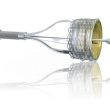Original Title: Transcatheter Aortic Valve Replacement versus Surgical Valve Replacement in Intermediate-Risk Patients: A Propensity Score Analysis. Reference: Vinod H Thourani et al. Lancet Published Online April 3, 2016. Courtesy of Dr. Carlos Fava. The transcatheter Aortic Valve Replacement (TAVI) has shown benefits in high risk patients or inoperable patients, but there is little evidence<a href="https://solaci.org/en/2016/04/13/tavi-good-outcomes-with-intermediate-risk/" title="Read more" >...</a>
The SAPIEN 3 Valve Resulted Superior to Surgery in an Observational Study
The last generation of the balloon expandable valve resulted superior to surgery in intermediate riskpatients, in a registry analyzis. Patients treated with the SAPIEN 3 valve showed lower rates of death, stroke and paravalvular leak at one year than patients undergoing surgery. This third generation improves the SAPIEN XT with a skirt designed to prevent<a href="https://solaci.org/en/2016/04/08/the-sapien-3-valve-resulted-superior-to-surgery-in-an-observational-study/" title="Read more" >...</a>
CoreValve US Pivotal: at 3 Years, the Self-Expanding Valve Maintains Its Advantage vs. Surgery
At 3 year follow up, the CoreValve US Pivotal study on high risk elderly patients, the self-expanding valve showed a lasting benefit vs. surgery. These findings could suggest that the self-expanding valve should be considered the preferred treatment in patients with symptomatic severe aortic stenosis at increased risk for surgery. The study included 797 patients<a href="https://solaci.org/en/2016/04/08/corevalve-us-pivotal-at-3-years-the-self-expanding-valve-maintains-its-advantage-vs-surgery/" title="Read more" >...</a>
One year outcomes of the new repositionable and retrievable valve
Original Title: 1-Year Outcomes with the Fully Repositionable and Retrievable Lotus Transcatheter Aortic Replacement Valve in 120 High-Risk Surgical Patients with Severe Aortic Stenosis Results of the REPRISE II Study. Reference: Ian T. Meredith et al. J Am Coll Cardiol Intv. 2016;9(4):376-384. This analysis represents the first report at one year of 120 patients enrolled<a href="https://solaci.org/en/2016/02/23/one-year-outcomes-of-the-new-repositionable-and-retrievable-valve/" title="Read more" >...</a>
TAVI in patients older than 90: similar outcomes to those obtained in younger patients
Original title: Comparison of Outcomes of Transcathether Aortic Valve Implantation in Patients ≥90 Years Versus <90 Years. Reference: Yigal Abramowitz, et al. Am J Cardiol 2015;116:1110-1115. More and more 90 year old patients require transcatheter aortic valve replacement (TAVI); however, its benefits have not been studied in this particular population. This study enrolled 734 patients<a href="https://solaci.org/en/2015/11/16/tavi-in-patients-older-than-90-similar-outcomes-to-those-obtained-in-younger-patients/" title="Read more" >...</a>
SAPIENS 3: Favorable outcomes with TAVI in intermediate risk patients
Transcatheter aortic valve replacement is a safe and effective alternative to surgery in patients with severe aortic stenosis and high surgical risk as the 5-year results of PARTNER 1 Alternate showed. The aim of this study was to evaluate the result of the Edwards Sapien 3 valve in patients with severe aortic stenosis and intermediate<a href="https://solaci.org/en/2015/06/24/sapiens-3-favorable-outcomes-with-tavi-in-intermediate-risk-patients/" title="Read more" >...</a>
NOTION: TAVR in low-risk patients
The aim of this study was to compare the results of transcatheter aortic valve replacement (TAVR) versus surgery in unselected patients with severe degenerative aortic stenosis. Patients were randomized 1:1 to TAVR (n = 145) or surgical replacement (n = 135). Those of TAVR group received Medtronic CoreValve self-expanding valve. The femoral access was used<a href="https://solaci.org/en/2015/06/24/notion-tavr-in-low-risk-patients/" title="Read more" >...</a>
PARTNER to 5 years. TAVR is an effective alternative to surgery in high risk patients
This study included 699 patients with severe aortic stenosis and high surgical risk of whom 348 received transcatheter aortic valve replacement (TAVR) and 351 received surgery. Previous reports of the results to one, two and three years and this work published simultaneously in Lancet reports the final follow-up at 5 years. The mortality at follow-up<a href="https://solaci.org/en/2015/06/24/partner-to-5-years-tavr-is-an-effective-alternative-to-surgery-in-high-risk-patients/" title="Read more" >...</a>
MITRAL: First cases of Transcatheter Mitral Valve Implantation (TMVI)
Severe mitral regurgitation is three times more prevalent than aortic stenosis in the elderly population at high risk and poor prognosis if not treated. Fortis mitral valve was designed using several preclinical models and are now tested for the first time in 4 patients resulting in various technical difficulties and finally the death of 3<a href="https://solaci.org/en/2015/06/24/mitral-first-cases-of-transcatheter-mitral-valve-implantation-tmvi/" title="Read more" >...</a>
TAVI registry: Iberoamerica
The objective of this presentation (n = 1248 p, 43 centers in Europe and Latin America) is to evaluate immediate and long-term results of patients with high risk aortic stenosis classified as inoperable in the “real world”. C. Moris2012-05-15






